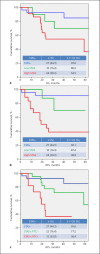The More Extensive the Spread through Air Spaces, the Worse the Prognosis Is: Semi-Quantitative Evaluation of Spread through Air Spaces in Pulmonary Adenocarcinomas
- PMID: 35947971
- PMCID: PMC10129026
- DOI: 10.1159/000525456
The More Extensive the Spread through Air Spaces, the Worse the Prognosis Is: Semi-Quantitative Evaluation of Spread through Air Spaces in Pulmonary Adenocarcinomas
Abstract
Introduction: The extent of spread through air spaces (STAS) is less investigated among patients with lung adenocarcinoma who underwent sublobar resection. Therefore, we aimed to evaluate the extent of STAS semi-quantitatively, to assess its prognostic impact on overall survival (OS) and recurrence-free survival (RFS), and to investigate the reproducibility of this assessment.
Methods: The number of tumour cell clusters and single tumour cells within air spaces was recorded in three different most prominent areas (200x field of view). The extent of STAS was categorized into three groups, and the presence of free tumour cluster (FTC) was recorded.
Results: Sixty-one patients were included. Recurrence was more frequent with higher grade (p = 0.003), presence of lymphovascular invasion (p = 0.027), and presence of STAS of any extent (p = 0.007). In multivariate analysis, presence of FTC (HR: 5.89; 95% CI: 1.63-21.26; p = 0.005) and more pronounced STAS (HR: 7.46; 95% CI: 1.60-34.6; p = 0.01) had adverse impact on OS and RFS, respectively. Concerning reproducibility, excellent agreement was found among STAS parameters (ICC range: 0.92-0.94).
Discussion: More extensive STAS is an unfavourable prognostic factor in adenocarcinomas treated with sublobar resection. As the evaluation of extent of STAS is reproducible, further investigation is required to gather more evidence.
Keywords: Free tumour cluster; Pulmonary adenocarcinoma; Semi-quantitative analysis; Spread through air spaces; Sublobar resection.
© 2022 The Author(s). Published by S. Karger AG, Basel.
Conflict of interest statement
The authors have no conflicts of interest to declare.
Figures



Similar articles
-
Impact of surgery and adjuvant chemotherapy on the survival of stage I lung adenocarcinoma patients with tumor spread through air spaces.Lung Cancer. 2023 Mar;177:51-58. doi: 10.1016/j.lungcan.2023.01.009. Epub 2023 Jan 18. Lung Cancer. 2023. PMID: 36736075
-
Spread Through Air Spaces in Stage I to III Resected Lung Adenocarcinomas: Should the Presence of Spread Through Air Spaces Lead to an Upstaging?Am J Surg Pathol. 2024 May 1;48(5):596-604. doi: 10.1097/PAS.0000000000002188. Epub 2024 Feb 1. Am J Surg Pathol. 2024. PMID: 38298024
-
Prognostic significance of tumor spread through air spaces in patients with stage IA part-solid lung adenocarcinoma after sublobar resection.Lung Cancer. 2021 Feb;152:21-26. doi: 10.1016/j.lungcan.2020.12.001. Epub 2020 Dec 5. Lung Cancer. 2021. PMID: 33338924
-
Updates on spread through air spaces (STAS) in lung cancer.Histopathology. 2020 Aug;77(2):173-180. doi: 10.1111/his.14062. Epub 2020 Jul 1. Histopathology. 2020. PMID: 31943337 Review.
-
Meta-analysis of Lobectomy and Sublobar Resection for Stage I Non-small Cell Lung Cancer With Spread Through Air Spaces.Clin Lung Cancer. 2022 May;23(3):208-213. doi: 10.1016/j.cllc.2021.10.004. Epub 2021 Oct 23. Clin Lung Cancer. 2022. PMID: 34799251 Review.
Cited by
-
Deep learning-based detection and semi-quantitative model for spread through air spaces (STAS) in lung adenocarcinoma.NPJ Precis Oncol. 2024 Aug 5;8(1):173. doi: 10.1038/s41698-024-00664-0. NPJ Precis Oncol. 2024. PMID: 39103596 Free PMC article.
-
Proposal of a grading system for squamous cell carcinoma of the lung - the prognostic importance of tumour budding, single cell invasion, and nuclear diameter.Virchows Arch. 2023 Sep;483(3):393-404. doi: 10.1007/s00428-023-03612-8. Epub 2023 Aug 9. Virchows Arch. 2023. PMID: 37555982 Free PMC article.
-
Clinical Importance of Grading Tumor Spread through Air Spaces in Early-Stage Small-Lung Adenocarcinoma.Cancers (Basel). 2024 Jun 14;16(12):2218. doi: 10.3390/cancers16122218. Cancers (Basel). 2024. PMID: 38927923 Free PMC article.
References
-
- Torre LA, Bray F, Siegel RL, Ferlay J, Lortet-Tieulent J, Jemal A. Global cancer statistics, 2012. CA Cancer J Clin. 2015 Mar;65((2)):87–108. - PubMed
-
- Altorki NK, Yip R, Hanaoka T, Bauer T, Aye R, Kohman L, et al. Sublobar resection is equivalent to lobectomy for clinical stage 1A lung cancer in solid nodules. J Thorac Cardiovasc Surg. 2014 Feb;147((2)):754–754. - PubMed
-
- Suzuki K, Koike T, Asakawa T, Kusumoto M, Asamura H, Nagai K, et al. A prospective radiological study of thin-section computed tomography to predict pathological noninvasiveness in peripheral clinical IA lung cancer (Japan Clinical Oncology Group 0201) J Thorac Oncol. 2011 Apr;6((4)):751–756. - PubMed
-
- Aokage K, Yoshida J, Hishida T, Tsuboi M, Saji H, Okada M, et al. Limited resection for early-stage non-small cell lung cancer as function-preserving radical surgery: a review. Jpn J Clin Oncol. 2017 Jan;47((1)):7–11. - PubMed
-
- Hung JJ, Jeng WJ, Hsu WH, Chou TY, Huang BS, Wu YC. Predictors of death, local recurrence, and distant metastasis in completely resected pathological stage-I non-small-cell lung cancer. J Thorac Oncol. 2012 Jul;7((7)):1115–1123. - PubMed
MeSH terms
LinkOut - more resources
Full Text Sources
Medical
Research Materials

